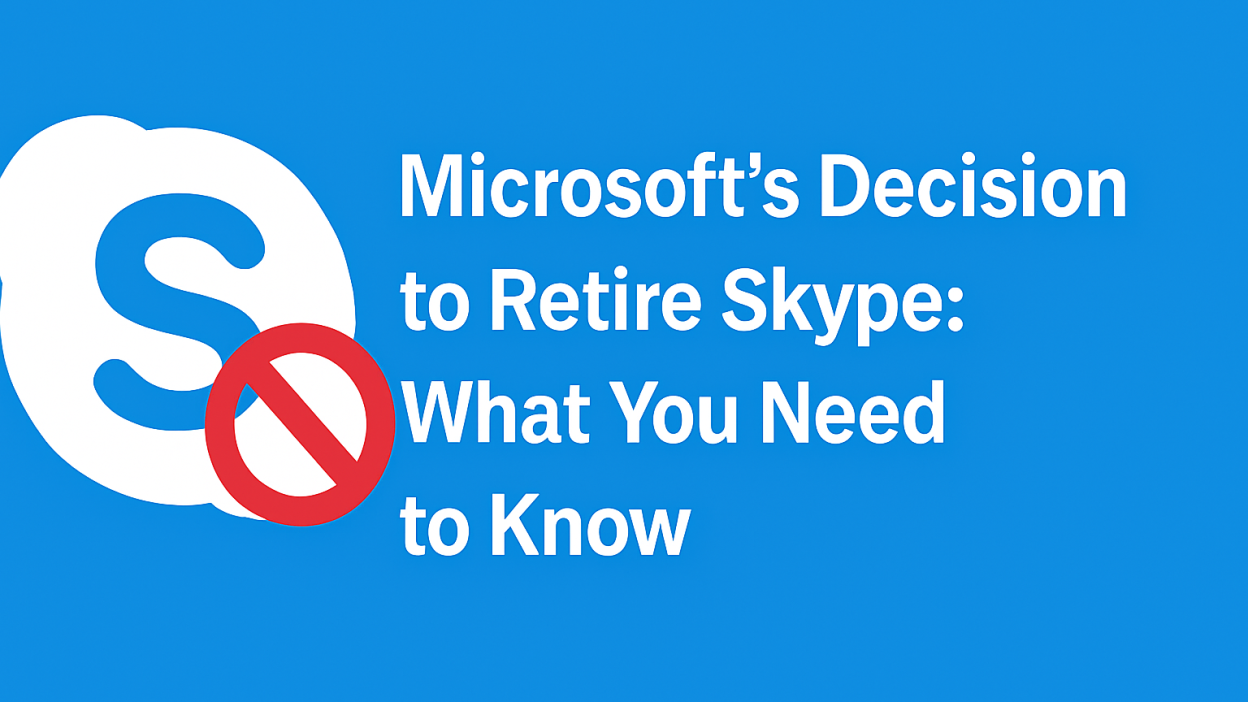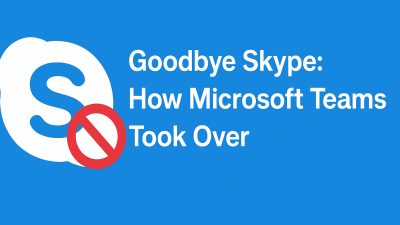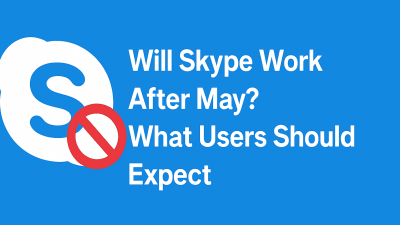For a lot of users, Microsoft ending Skype might feel like a slow fade-out. You hear the date, see the reminder in your app, and assume it’s just another product that reached the end of its life.
But this isn’t just a sunset. It’s a strategic shift a clear signal from Microsoft that the way they want users to communicate is changing.
Skype has been part of the digital landscape for over two decades. At its peak, it was online video calling. But the tech world evolved fast, and Microsoft quietly shifted its focus long before making the official call.
By shutting Skype down in 2025 and urging users to move to Microsoft Teams, they aren’t just retiring a product. They’re resetting the foundation of how they want people, especially those inside the Microsoft ecosystem, to connect, collaborate, and communicate.
And when a company this big makes that kind of move, it’s worth asking:
1- What drove the decision?
2- Who benefits?
3- And what does it say about where the communication space is headed?
Skype Was Still Working — But It Was Out of Place
Skype still worked. You could call people, host video chats, send messages, and share files. For many users, it was simple, predictable, and familiar.
But “working” isn’t the same as “aligned.”
By 2024, Skype had become an outlier inside Microsoft’s product family. It wasn’t integrated into their productivity tools. It didn’t follow the same design patterns. It didn’t connect easily with OneDrive, Outlook, SharePoint, or even Microsoft 365.
Meanwhile, Microsoft Teams was being pushed everywhere — in workspaces, classrooms, and even casual family settings. Teams was embedded in Windows. It synced with calendars. It tied into files and workflows. It played nicely with the rest of Microsoft’s growing digital hub.
So even though Skype still functioned, it didn’t match the direction Microsoft was building toward.
That disconnect between what Skype did and where Microsoft was headed became impossible to ignore.
Why Microsoft Chose to Let Skype Go
This wasn’t a quick decision. Microsoft had been shifting toward Teams for years. But by officially retiring Skype in May 2025, they’re closing the door on a product that once defined online calling — and making a few big statements in the process.
Here’s what Microsoft’s decision signals:
One of the biggest factors behind the shutdown is the feature overlap.
By 2022, Microsoft Teams had absorbed almost every function Skype offered:
-
Video and voice calls
-
Chat messaging
-
File sharing
-
Screen sharing
-
Contact management
In many cases, Teams even improved on them. It offered persistent chat threads, meeting scheduling, cloud file storage, and integration with Office apps.
Supporting both platforms meant doubling the work for the same user needs. And from a business perspective, that’s a hard sell.
What Microsoft realized was this:
“We don’t need two apps that solve the same problems. We need one powerful, scalable platform that can serve everyone.”
So the choice was clear: retire Skype and fold its users into Teams — the platform with more momentum and a clearer future.
This wasn’t about abandoning users. It was about simplifying the system for Microsoft and for the people using their products every day.
The Bigger Picture: Platform Thinking Over Standalone Tools
There’s another layer to this decision that often gets missed in surface-level coverage: Microsoft isn’t just pushing people toward Teams — they’re pushing people toward platform dependence.
In the old days, Skype was standalone. You could download it, create a username, and start making calls. No need to tie it into your documents, your email, or your calendar.
Teams is different.
It’s part of a broader Microsoft ecosystem — one that includes:
-
Outlook for scheduling
-
OneDrive for file sharing
-
Office apps for collaboration
-
Azure for cloud identity
-
Microsoft 365 for subscriptions
That gives Microsoft more flexibility, and users more capability — but it also ties users more deeply into their platform.
This is the same strategy companies like Apple, Google, and Meta are following: create tightly integrated systems that make it harder to switch, but easier to stay.
Retiring Skype was a move toward that future — one where communication isn’t just a tool you open, but a layer inside everything else you do.
Skype’s Simplicity Became Its Limitation
One of the reasons users loved Skype was because it was simple. It didn’t try to do too much. You logged in, you called someone, you chatted. That was it.
But as other apps evolved — especially during the pandemic — people started expecting more from their communication tools.
They wanted:
-
Virtual meeting rooms
-
File history synced to the cloud
-
Scheduled recurring calls
-
Notifications integrated with email
-
Real-time collaboration on shared documents
Skype didn’t evolve fast enough to keep up. And it wasn’t built with these modern workflows in mind.
Teams, on the other hand, was designed for that kind of depth from day one. It might not be as intuitive for casual users, but it’s better positioned to grow with user needs.
Microsoft knew that Skype couldn’t be reshaped to compete in that space. So rather than force a redesign, they made a clean break — and pointed everyone toward the tool they believe is better equipped for the long haul.
Ending Skype Was a Strategic Tradeoff, Not a Shutdown for Failure

Let’s clear up a common misconception: Microsoft didn’t shut Skype down because it failed.
Skype still had millions of users. It still handled international calls, team check-ins, and weekend video chats.
What happened here was more like this:
Microsoft looked at its product stack and said: “We don’t need two tools doing the same thing, let’s back the one that fits our future.”
In that light, Skype wasn’t a casualty of poor performance. It was a victim of overlapping purpose.
From Microsoft’s perspective, supporting two products diluted their message. It confused users. It spread their teams too thin.
So instead of letting Skype linger or forcing it to play catch-up, they chose to make the call, back Teams, and move forward with one platform.
It was a tradeoff clean, intentional, and aligned with a much bigger play.
You’re Not Just Losing an App — You’re Losing a Workflow
When a tool like Skype shuts down, it’s easy to focus on the technical side: dates, data exports, logins. But for a lot of users, this is about more than software. It’s about the small routines that built into their lives.
Maybe you used Skype to check in with overseas family on weekends. Or maybe it was the way you handled freelance calls. Maybe it was just your reliable fallback for quick video chats.
So when Microsoft retires Skype on May 5, 2025, you’re not just losing access. You’re being asked to rewire how you connect with people and in many cases, adapt to a platform you didn’t ask for.
This part of the guide is here to help you move through that process, not just logistically, but practically.
We’ll cover:
-
What’s actually going to stop working
-
What happens to your data and subscriptions
-
How to use Teams (if you choose to)
-
What to do if Teams doesn’t work for you
-
When to act — and what not to leave until the last minute
What Happens on May 5, 2025?
Here’s what you need to know: Skype isn’t getting phased out slowly. It’s being shut down completely for all regular (consumer) users.
On May 5, 2025, the following will happen:
-
You will no longer be able to log into the Skype app
-
You won’t be able to send or receive messages or calls
-
Group chats, contacts, and conversations will stop syncing
-
Skype Credit, paid numbers, and subscriptions will end
-
Files and messages stored in your Skype account will become inaccessible
There is no grace period beyond this date for using the app. Microsoft will allow data export and login access to your account only through their web tools for a limited time afterward, but not for using Skype itself.
What About Your Messages, Contacts, and Files?
This part is important — because what Microsoft is not doing is transferring all your data to Teams automatically.
Here’s what carries over:
-
Your login: If your Skype account was created with a Microsoft email (Outlook, Hotmail, etc.), that same login works for Teams.
-
Contacts: If your contacts were tied to your Microsoft account, they’ll appear in Teams.
-
Recent call logs: May be partially accessible if you log in to Teams with the same Microsoft ID.
What doesn’t carry over:
-
Old chat history: Your messages from Skype will not automatically appear in Teams.
-
Sent and received files: Attachments from your Skype chats won’t be available unless you saved or exported them.
-
Skype voicemail and call recordings: These are not migrated and must be manually backed up.
If any of that matters to you, there’s only one move: export your data before the shutdown.
How to Export Your Skype Data (Before It’s Too Late)

Microsoft allows you to download your Skype data through a request system. It’s not instant, so give yourself a few days.
Here’s the process:
-
Log in with your Skype/Microsoft account
-
Select the data you want:
-
Chat messages
-
Media and files
-
Contact list
-
-
Submit your request — you’ll receive an email once your archive is ready (usually within 24–72 hours)
-
Download the ZIP file and store it safely (external hard drive, Google Drive, Dropbox, etc.)
You’ll receive your chat logs in .json format, which can be viewed with browser tools or converted to readable text.
This is your only chance to keep your Skype memories and records, so don’t wait until the last minute.
What About Skype Credit or Paid Numbers?
If you’ve paid for Skype services — like calling landlines or having your own Skype number — here’s what to expect:
-
All subscriptions will continue only until April 3, 2025
-
After that, billing will stop, and access to those services will end
-
You can no longer purchase new Skype Credit or numbers
-
If you have remaining Skype Credit, Microsoft hasn’t confirmed automatic refunds — so use it if you can
-
A limited web-based “dial pad” might be available temporarily inside the Teams web portal, but this won’t be a long-term solution
If you rely on Skype for low-cost international calling, you’ll want to start testing alternatives now — we’ll cover those options shortly.
Is Microsoft Teams Really a Replacement?
Let’s be honest: Teams isn’t just “Skype with a new look.” It’s a totally different product, and it may or may not feel right depending on how you used Skype.
Here’s what you’ll notice when you switch:
-
More features: Teams includes calendars, shared files, persistent chat threads, meeting links, and more.
-
Structured interface: Instead of one contact list and chat window, you have tabs like “Chat,” “Teams,” “Calendar,” and “Calls.”
-
Designed for collaboration: Teams isn’t just for talking — it’s for working together in groups, managing tasks, and sharing resources.
If you only used Skype for personal calls or quick video check-ins, Teams might feel overbuilt. But if you’re open to adapting, the free personal version of Teams is available and capable.
Here’s what it includes:
-
Unlimited one-on-one and group video calls
-
Unlimited chat messages
-
File and photo sharing
-
Shared calendar with Outlook
-
Support for mobile and desktop
You can sign up or log in at teams.microsoft.com.
The interface will take getting used to — but the tools are solid if you’re willing to learn.
Don’t Want to Use Teams? You’ve Got Options
If Teams doesn’t fit your style, there’s no rule saying you have to use it. You can switch to whatever platform works for your life.
Here are solid Skype alternatives by use case:
For video and voice calls (easy setup):
-
Zoom – Great for group meetings and 1-on-1s
-
Google Meet – Runs in-browser, tied to Gmail
-
FaceTime – Best for Apple users
-
WhatsApp – Encrypted calls, popular for international use
For messaging + communities:
-
Discord – Good for ongoing group chats, file sharing, casual voice rooms
-
Slack (free) – More structured, good for teams or projects
-
Signal – Secure messaging with video/voice options
For international or phone number calling:
-
MyTello – Budget-friendly global calls without contracts
-
Google Voice – Free in the US, low-cost elsewhere
-
Viber – Still offers low-cost phone calls and messaging
Test what works — your contacts may already be using some of these tools.
What You Should Do Now (Your Checklist)
Here’s a practical list of what to do now — even if you’re not sure what platform you’ll switch to yet.
-
Log into Skype
-
Check if anything important is saved: messages, contacts, files
-
-
Export your data
-
Go to the export portal and request your archive
-
-
Check your Skype Credit
-
Use it or contact Microsoft Support if you want a refund
-
-
Tell your contacts where to find you
-
Whether you’re moving to Teams, Zoom, WhatsApp, or something else
-
-
Test your new tool early
-
Download, log in, and try a call or chat — don’t wait for May
-
-
Uninstall Skype (once ready)
-
Or leave it alone until it stops working — but don’t rely on it
-
Being proactive now will save you from scrambling later.
Final Take: The Shutdown Is Real — But So Are Your Options
Yes, Skype is ending. And no, you can’t stop that. But what you can do is take control of what happens next.
You’ve got tools. You’ve got time. You’ve got more choice than Microsoft’s announcement might make it seem.
Whether you stick with Teams or go in a completely different direction, the key is to do it before May rolls around. Because once Skype’s gone, there’s no going back.
And if you need help choosing what’s next, we’ve got more guides coming to walk you through it, clearly, calmly, and with no pressure to pick one “right” answer.
Questions About the Skype Shutdown
1. Will my Skype messages transfer automatically to Microsoft Teams?
No, your messages and chat history from Skype will not appear in Teams automatically. To keep your conversations, you’ll need to export your Skype data manually before the May 2025 shutdown.
2. What happens to my Skype account after May 5, 2025?
After that date, you’ll no longer be able to log into the Skype app or access any of your messages, files, or contacts. Your data will remain available for export through Microsoft’s portal for a limited time, but only outside the Skype interface.
3. Can I still use my Skype login to access Microsoft Teams?
Yes. If your Skype account is linked to a Microsoft email (Outlook, Hotmail, etc.), you can use the same login credentials to access the free version of Microsoft Teams.
4. How long will Microsoft keep my Skype data after the shutdown?
Microsoft has stated that user data will be retained until the end of 2025, after which all Skype-related data — including chat logs, contacts, and account info — will be permanently deleted from their servers.
5. What happens to Skype Credit if I don’t use it before shutdown?
Skype Credit will expire when the service ends unless Microsoft offers a refund or transfer process, which hasn’t been fully confirmed. It’s best to use any remaining balance before April 2025.
6. Can I keep using my Skype Number after the shutdown?
No. All paid Skype Number subscriptions will be canceled by April 3, 2025. After that, Microsoft will no longer renew or support those services for consumers.
7. Does Teams let me call regular phone numbers like Skype did?
Only the paid version of Microsoft Teams (via Teams Phone) allows you to call landlines or mobile numbers. This feature isn’t available in the free personal version, so you’ll need to look at alternatives if that’s something you use often.




